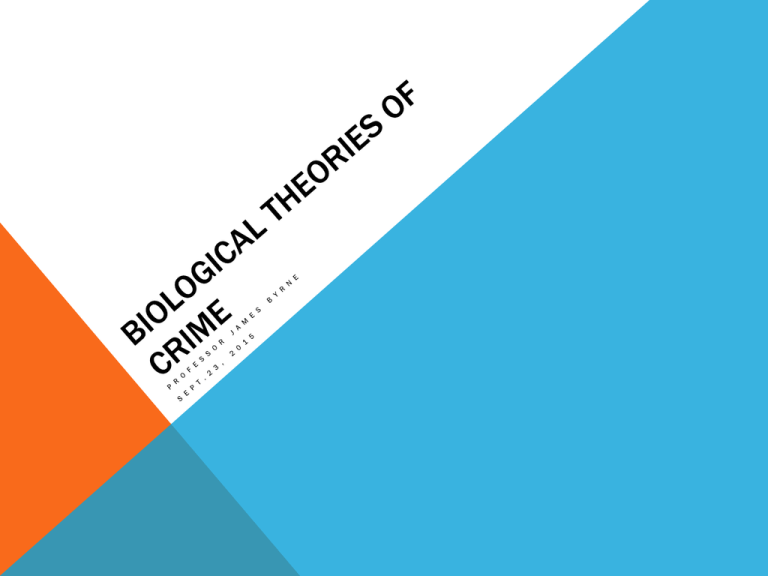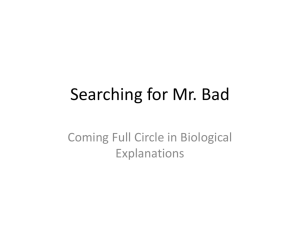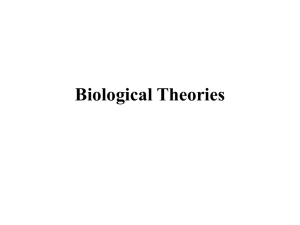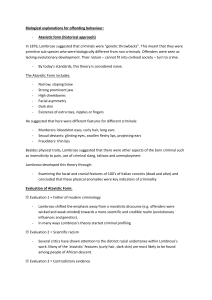Biological Theories of Crime
advertisement

IS CRIME BIOLOGICALLY DETERMINED? BIOLOGICAL CRIMINOLOGY: THE EARLY YEARS The basic assumption of early biological criminologists, such as the Italian criminologist Cesare Lombroso (1835- 1909) was that crime was determined by an individual's biological make-up, i.e. that some persons were born criminals who could not control their actions. http://live.huffingtonpost.com/r/segment/spot-murderer-braingenetics/518cfe8602a7605090000048 LOMBROSO’S THEORY OF CRIME CAUSATION .It is important to keep in mind that Lombroso did not argue that all crime could be explained by biological factors. He estimated that offenders with atavistic tendencies (i.e. throwbacks to earlier more primitive man) were responsible' for about a third of all crime. Although Lombroso's research on the physical characteristics of offenders was dismissed due to its poor quality, we simply have not yet studied the biologycrime connection in sufficient detail to make any definitive statements about the theory itself. WILLIAM SHELDON: BODY TYPES AND CRIMINAL BEHAVIOR Mesomorphs – muscular/athletic (aggression) Ectomorphs – tall/thin (intellectual) Endomorphs – heavy/slow (fences) William Sheldon suggested somatotype (body-build) makes people susceptible to delinquent behavior NEW DEVELOPMENTS IN BIOLOGICAL CRIMINOLOGY there has been a recent resurgence of interest in a range of biological factors, including genetics (e.g. XYY syndrome, IQ), biochemical and neurophysiological factors (e.g. diet, food allergies, EEG abnormalities). Perhaps the most compelling argument in support of bio-criminology was offered by James Q. Wilson and Richard Herrnstein. After reviewing all the available research on biology and crime, these two authors argued that at least one type of crime --predatory street crime--can be explained by "showing how human nature develops from the interplay of psychological, biological, and social factors” (1986: 1). BIOLOGY AND ENVIRONMENT; BIO-SOCIAL A BRIEF OVERVIEW OF KEY RESEARCH Lombroso’s research on tattoos and Italian prisoners Sheldon’s research on college students Twin Studies Adoption Studies IQ and Crime XYY and beyond: In Search of the Crime gene BIOLOGY AND CRIME CONTROL POLICY Rutgers University Professor James Finckenauer has suggested that individual treatment plans would vary by the type of problem, but that correctional interventions could include chemotherapy (for genetic and hormonal problems), special education for learning disabilities, and megavitamin therapy for offenders with diet-related problems. No estimates are available on the size of the current offender population that is affected, either directly or indirectly, by these biological factors, but it seems safe to-predict that before probation and parole agencies could address the needs of these offenders, money for treatment would have to be found. It also seems likely that a policy of selective incapacitation would need to be implemented to "control" the treatment failures that inevitably would emerge from these community-based programs. BIOLOGY AND PUBLIC POLICY Biological Criminology and Community Corrections Practice Theoretical Assumptions Some individuals have genetically-linked characteristics ( such as low IQ, learning disabilities, high serotonin levels, underdeveloped autonomic nervous systems) that predispose them to criminal behavior. Intervention Strategy Examples of Programs/Strategies Strategies designed to (1) The use of specialized identify offenders with community supervision biological characteristics that caseloads utilizing treatment increase their risk of criminal and control strategies for sex behavior and (2) provide offenders, and for violent/ individual treatment to address assaultive offenders. the problem identified, through drug treatment, and other behavioral interventions.







